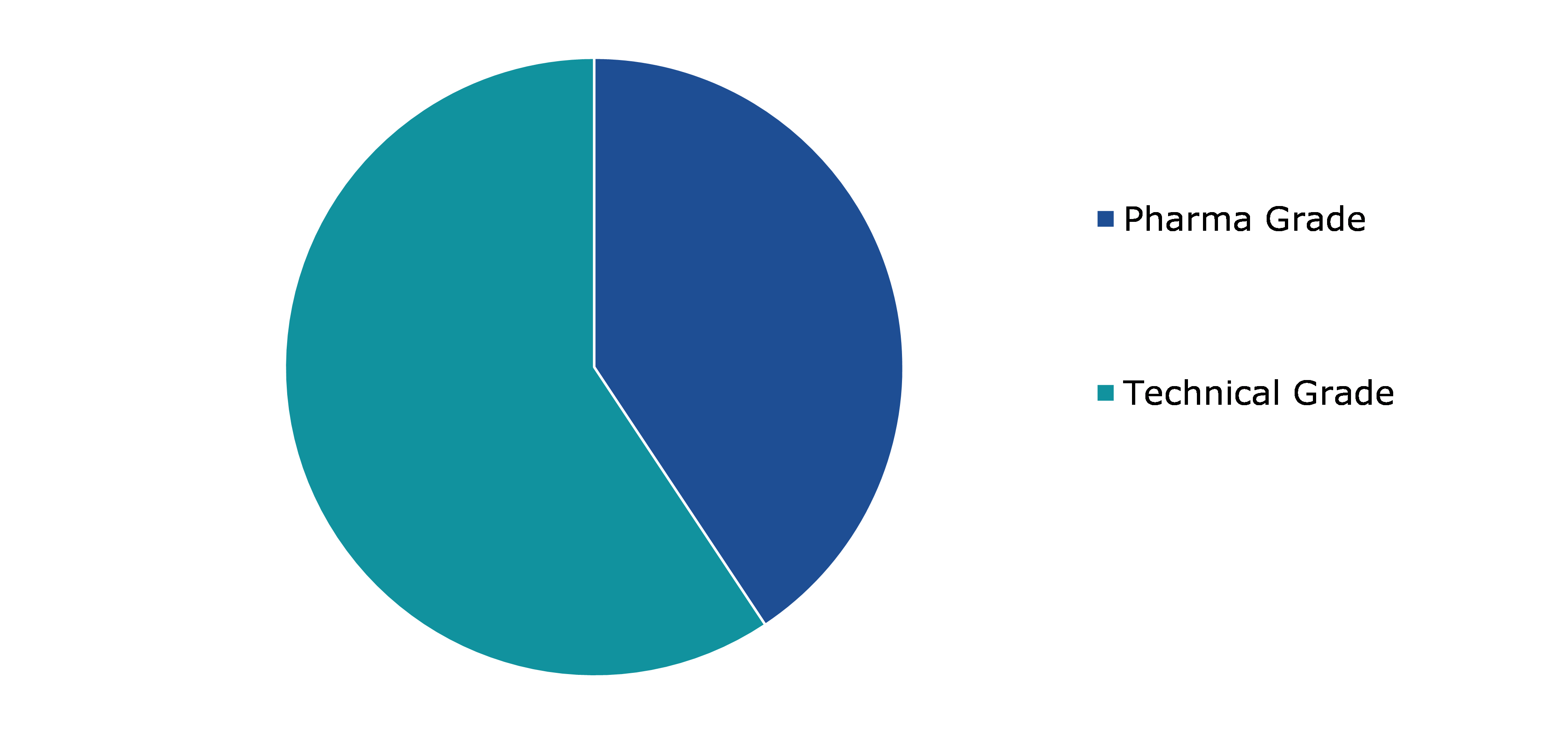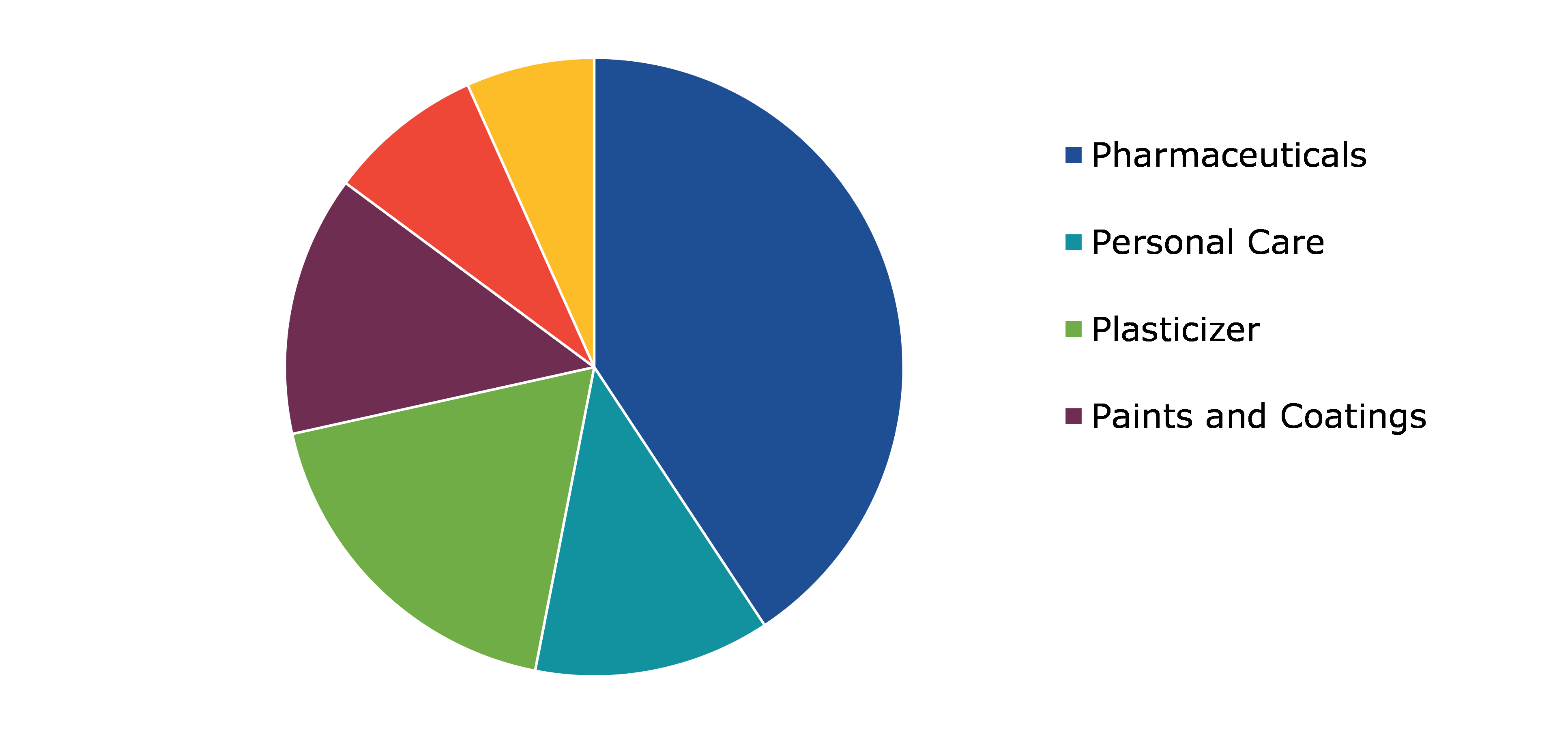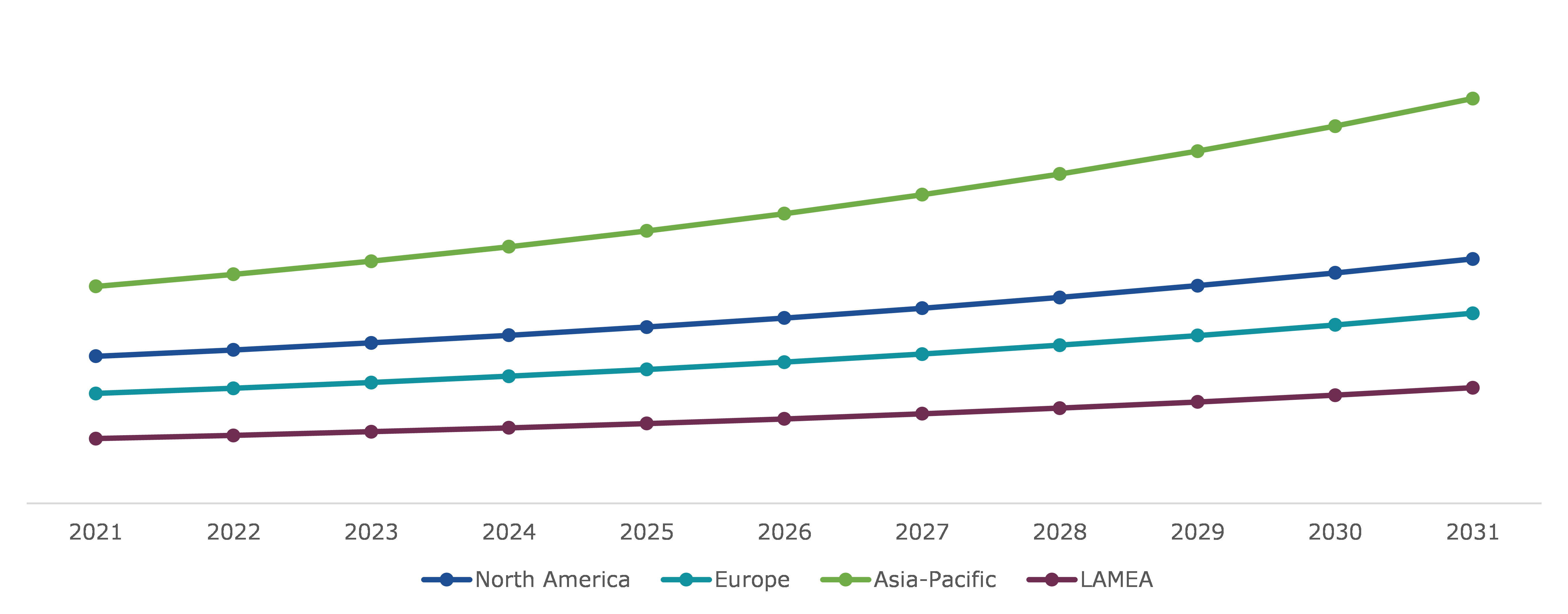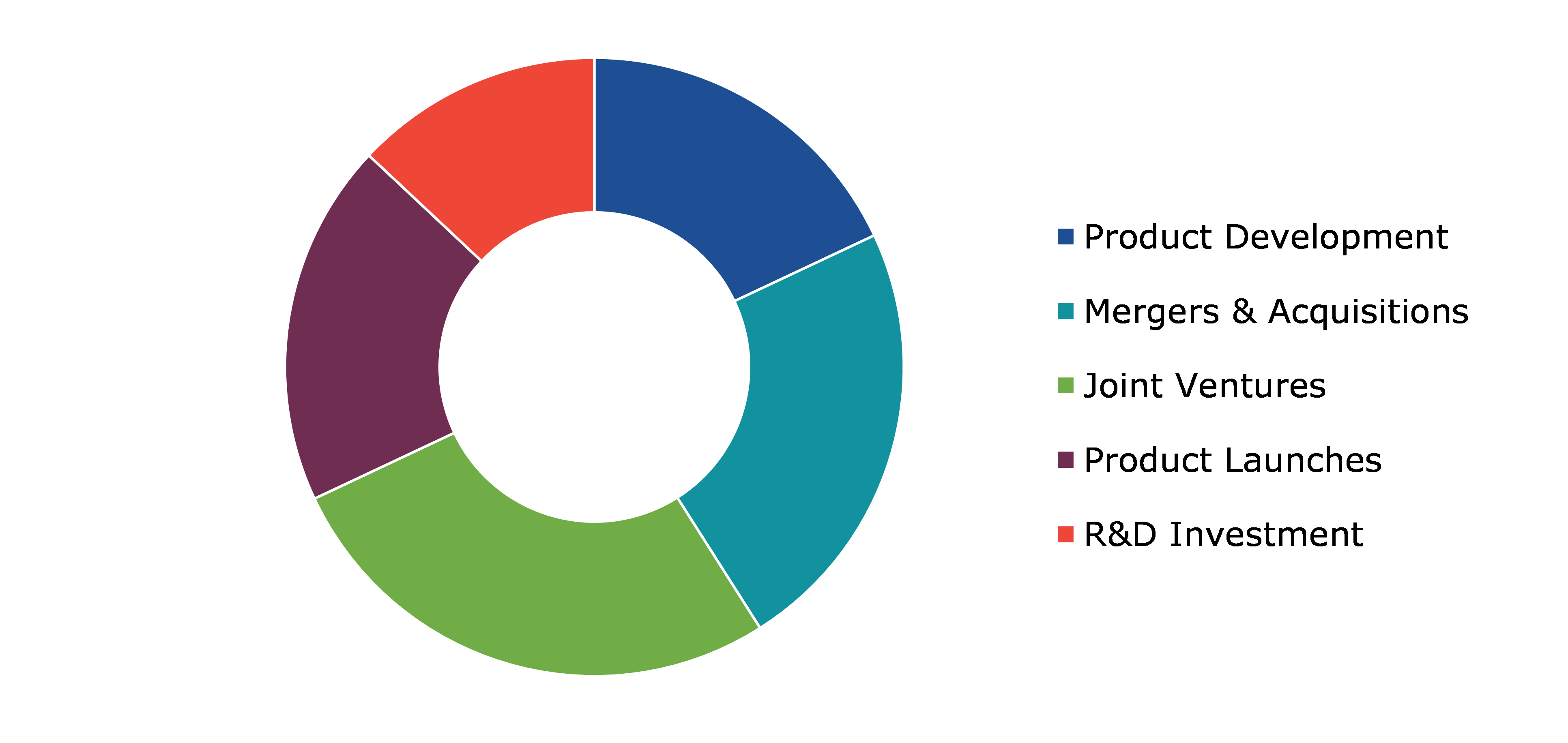Synthetic Camphor Market Report
RA00343
Synthetic Camphor Market by Grades (Pharma Grade and Technical Grade), Application (Pharmaceutical, Personal Care, Plasticizer, Paints & Coatings, Flavor & Fragrances, and Others), Regional Analysis (North America, Europe, Asia Pacific, and LAMEA): Global Opportunity Analysis and Industry Forecast, 2022–2031
Global Synthetic Camphor Market Analysis
The global synthetic camphor market size was $395.1 million in 2021 and is predicted to grow with a CAGR of 6.0 %, by generating a revenue of $ 700.9 million by 2031.
Global Synthetic Camphor Market Synopsis
Synthetic camphor is derived from turpentine, where alpha-pinene is converted to camphene, which esterifies to bornyl acetate. Camphor tree oil contains natural camphor, a white crystalline powder with a distinctive penetrating pungent and fragrant odor.
Synthetic camphor is used in the production of cellulose nitrate, polyvinyl chloride, and polymers. It is also used as a medication, antiseptic, and bug powder. Synthetic camphor can also be used to improve ballistic qualities as a stabilizer and moderator in smokeless powder. Such a wide range of application is anticipated to have a positive impact on global synthetic camphor market share growth.
However, regulatory restrictions on the use of camphor in pharmaceutical products are expected to impact the growth of pharma-grade synthetic camphor market.
Increase in scope of applications of plastics has been verified to act in favor of synthetic camphor because it is used as a softener in the production of celluloid and PVC plastics. Furthermore, synthetic camphor formulations are noted to be useful in many health ailments. Although, it is not approved for the oral route of administration because of its toxicity, synthetic camphor is widely utilized in the production of inhalant and topical drug formulations.
According to regional analysis, the Asia Pacific synthetic camphor market accounted for the highest market size in 2021. Countries like India and China offers a vast growth opportunity for synthetic camphor because, majority of people in these countries use pharma grade synthetic camphor to treatment and relief of breathing issues and cold & cough.
Synthetic Camphor Overview
Synthetic camphor is often made from camphor tree concentrates and is produced by chemical combination through esterification, saponification, and oxidation process. Turpentine oil is a key raw ingredient used in the production of synthetic camphor. Synthetic camphor offers two assessments of products that are entirely distinguished in terms of their immaculateness. Pharmaceutical analysis synthetic camphor is a high value product that contains more than 98 percent synthetic camphor and is used in the manufacture of inhalants, for instance, nasal decongestants, and topical products such as muscle rub salves.
COVID-19 Impact on Global Synthetic Camphor Market
The COVID-19 pandemic created several uncertainties, resulting in significant economic losses as various businesses around the world came to a halt. During the COVID-19 crisis, global synthetic camphor market trenc experienced a modest halt since all manufacturers were closed and only essential necessities could be supplied. This has ultimately lowered the demand for synthetic camphor due to disruptions in supply chain, closure of manufacturing plants, and economic slowdown across several countries. Since the lockdown was lifted to improve economic conditions, manufacturers are working hard to establish traction and attract clients globally through creative launches and technological advancements. Government initiatives, a larger consumer base, lifestyle changes, higher disposable incomes, and a greater emphasis on healthcare and cleanliness are all factors contributing to recovery.
To boost the chemical industry, the government has taken several progressive steps, including the economic stimulus package, the Production Linked Incentive (PLI) Scheme, tax and labor reforms, the establishment of the National Infrastructure Pipeline (NIP), and various chemical industry-specific policies and schemes, such as its public procurement policy, mandatory BIS standards, skill development programs, and the renewal of the Petroleum, Chemicals, and Petro-chemical Investment Region (PCPIR) policy. The Indian chemical industry is predicted to emerge as a worldwide manufacturing center, owing to strong government support and a changing global chemical industry landscape. With the progress of chemical industries, the demand for synthetic camphor will accelerate post-COVID which is likely to expand the global synthetic camphor market opportunity growth in the forecast year.
Growing Applications of Synthetic Camphor in Industrial Sector to Drive the Market Growth
Synthetic camphor is used in the manufacture of pesticides such as moth and mosquito repellants. With increased awareness of synthetic camphor's air-purifying characteristics, demand for synthetic camphor powder has increased from downstream producers of synthetic camphor tablets. In addition to the two aforementioned grades of synthetic camphor, a few producers are known to offer synthetic camphor powder and pills.
Synthetic camphor, which is employed as a plasticizer in the production of celluloid and PVC plastics, has benefited from the growing variety of uses for plastics. Several medical problems have been reported to benefit from synthetic camphor compositions. Furthermore, synthetic camphor formulations have been found to be beneficial in a variety of medical conditions like breathing disorders. Even though it is not licensed for oral administration because of its toxicity, synthetic camphor is commonly employed in the manufacture of inhalant and topical medicinal compositions. Such advantages are predicted to drive the global synthetic camphor market revenue growth in the forecast period.
Rising Intense Competitive Rivalry among Manufacturing Companies to Restrain Market Growth
Due to increased rivalry in the chemical industry in Asia-Pacific, a few manufacturing units have closed their manufacturing facilities in the global synthetic camphor market. Another aspect that has contributed to this is the recent spike in raw material prices, such as of turpentine oil. Because the synthetic camphor industry is particularly cost sensitive, producers with insufficient cash or debt choose to abandon the market.
Furthermore, because of the supply-demand disparity, existing synthetic camphor manufacturers are working hard to meet demand. Furthermore, it should be highlighted that the market for synthetic camphor is at a point where any further disruption in synthetic camphor throughput from these manufacturers disrupts the entire value chain. All such factors are likely to hinder the growth of global synthetic camphor market opportunity in the future.
Use of Synthetic Camphor in the Manufacturing of Plastics is Anticipated to Generate Excellent Growth Opportunities
Since it is utilized as a plasticizer in the creation of celluloid and PVC plastics, synthetic camphor has profited from an expanding number of plastics uses. Furthermore, it has been found that synthetic camphor is beneficial for a variety of health conditions. Synthetic camphor is frequently employed in the production of inhalant and topical medication formulations, even though it is not permitted for oral administration due to its lethality. Non-physician-endorsed medications and OTC (over the counter) deals boost the production of such things and have a small but significant impact on the synthetic camphor industry.
Global Synthetic Camphor Market Trends, by Grades
By grades, the market has been divided into pharma and technical grade. Among these, the technical grade sub-segment accounted for the highest market share in 2021 whereas the pharma sub-segment is estimated to show the fastest growth during the forecast period.
Global Synthetic Camphor Market Share, by Grade, 2021
Source: Research Dive Analysis
The technical grade sub-type is anticipated to have a dominant market share in 2021.Traditionally, crude oil was an essential raw material to produce plastics. However, since resources are finite and becoming scarcer, science and industry are looking intensively for bio-based alternatives. “Camphor-based polymers” are used to make residual materials from pulp production usable for the manufacture of plastics. In addition, its chemical structure has a high potential for the production of bio-based monomers for polyamides and polyesters. Moreover, in contrast to castor oil production, both the extraction and processing of camphor are unproblematic. In addition, only a single synthesis step is required to produce the targeted bio monomers of the camphor-based plastics.
The pharma sub-type is anticipated to show the fastest growth and shall generate a considerable revenue in 2021. Camphor was traditionally produced by distilling the bark and wood of the camphor tree. Camphor is now often made from turpentine oil. It is found in products such as Vicks VapoRub.Pharma grade synthetic camphor is applied to the skin to ease pain and irritation. Furthermore, it is applied on the skin of the neck and chest so that it can be breathed in to relieve coughing. Also, many studies have shown that using camphor alone or in combination with other treatments can be quite beneficial in treating and preventing some major disorders. According to a cancer study, using camphor odor as a conditioning agent for YC8 lymphoma cancer cells in mice may have a suppressive effect on tumor growth when paired with immunotherapy treatment.
Global Synthetic Camphor Market Growth, by Application
On the basis of application, the market has been divided into pharmaceuticals, personal care, plasticizer, paints & coatings, flavor & fragrances, and others. Among these, the pharmaceutical sub-segment accounted for the highest market share in 2021 whereas the personal care sub-segment is estimated to show the fastest growth during the forecast period.
Global Synthetic Camphor Market Share, by Application, 2021
Source: Research Dive Analysis
The Pharmaceutical sub-type is anticipated to show dominant growth in 2021.Camphor is a natural substance that has a wide range of applications in both traditional and modern medicine.It has traditionally been used as a cold cure to relieve chest congestion and to treat inflammation-related disorders such as rheumatism, sprains, bronchitis, asthma, and muscle discomfort. Camphor is typically made as a balm, oil, or cream to treat joint and muscle pain and inflammation.Camphor oil along with cotton seed oil, causes a feeling of coldness when applied to the skin, which is related to the stimulation of nerve endings sensitive to cold.
Global Synthetic Camphor Market Size, Regional Analysis
The synthetic camphor market was investigated across North America, Europe, Asia-Pacific, and LAMEA.
Global Synthetic Camphor Market Size & Forecast, by Region, 2021-2031 (USD Million)
Source: Research Dive Analysis
The Market for Synthetic Camphor in Asia-Pacific is the Most Dominant
The Asia Pacific synthetic camphor market accounted for highest market share in 2021. Rise in consumption of camphor as a solvent in the personal care and healthcare industries across China and India is fueling the growth of this market in Asia-Pacific. Whereas in Asia-Pacific, the camphor tree is native to China, India, Mongolia, Japan, and Taiwan. Furthermore, the rise in consumer and e-commerce sectors is contributing to the growth of camphor market share across Asia-Pacific. Moreover, the growing transportation sector, changing lifestyle, and rise in disposable income is propelling the growth of this market in Asia-Pacific.
Competitive Scenario in the Global Synthetic Camphor Market
Investment and agreement are common strategies followed by major market players. For instance, private label analgesic is gaining popularity in the U.S. market as they do not require FDA approval and strong promotion by retailers. Walgreens Ultra Strength Muscle Rub (4% camphor) and Salonpas Pain Relieving Patch (1.2% camphor) are examples of private label analgesics that contain camphor. Surge in commodity exports, economic growth, and production capacity are expected to boost the growth of pharma-grade synthetic camphor market.
Source: Research Dive Analysis
Some of the leading synthetic camphor market players are Kanchi Karpooram Limited, Mangalam Organics Limited, Oriental Aromatics Limited, Aldon Corporation, Saptagir Camphor Limited, Nagase & Co. Ltd., Skyrun Industrial Co. Ltd., Spectrum Laboratory Products Inc., Wuzhou Huangpu Chemical Pharmaceutical Co. Ltd., Taiwan Tekho Camphor Co. Ltd., and others.
| Aspect | Particulars |
| Historical Market Estimations | 2020 |
| Base Year for Market Estimation | 2021 |
| Forecast Timeline for Market Projection | 2022-2031 |
| Geographical Scope | North America, Europe, Asia-Pacific, LAMEA |
| Segmentation by Grades |
|
| Segmentation by Application |
|
| Key Companies Profiled |
|
Q1. What is the size of the global synthetic camphor market?
A. The global synthetic camphor market size was $395.1 million in 2021 and is predicted to grow with a CAGR of 6.0 %, by generating a revenue of $ 700.9 million by 2031.
Q2. Which are the major companies in the synthetic camphor market?
A. Kanchi Karpooram Limited, Mangalam Organics Limited, Oriental Aromatics Limited, Aldon Corporation, Saptagir Camphor Limited, Nagase & Co. Ltd., Skyrun Industrial Co. Ltd., Spectrum Laboratory Products Inc., Wuzhou Huangpu Chemical Pharmaceutical Co. Ltd., Taiwan Tekho Camphor Co. Ltd., and others.
Q3. Which region, among others, possesses greater investment opportunities in the near future?
A. LAMEA possesses great investment opportunities for investors to witness the most promising growth in the future.
Q4. What will be the growth rate of the Asia-Pacific synthetic camphor market?
A. Asia-Pacific synthetic camphor market is anticipated to grow at 6.54 %CAGR during the forecast period.
Q5. What are the strategies opted by the leading players in this market?
A. Agreement and investment are the two key strategies opted for by the operating companies in this market.
Q6. Which companies are investing more in R&D practices?
A. Skyrun Industrial Co. Ltd., Spectrum Laboratory Products Inc., and Wuzhou Huangpu Chemical Pharmaceutical Co. Ltd., are the companies that invest more on R&D activities for developing new products and technologies.
1.Research Methodology
1.1.Desk Research
1.2.Real time insights and validation
1.3.Forecast model
1.4.Assumptions and forecast parameters
1.5.Market size estimation
1.5.1.Top-down approach
1.5.2.Bottom-up approach
2.Report Scope
2.1.Market definition
2.2.Key objectives of the study
2.3.Report overview
2.4.Market segmentation
2.5.Overview of the impact of COVID-19 on Global Synthetic Camphor market
3.Executive Summary
4.Market Overview
4.1.Introduction
4.2.Growth impact forces
4.2.1.Drivers
4.2.2.Restraints
4.2.3.Opportunities
4.3.Market value chain analysis
4.3.1.List of raw material suppliers
4.3.2.List of manufacturers
4.3.3.List of distributors
4.4.Innovation & sustainability matrices
4.4.1.Technology matrix
4.4.2.Regulatory matrix
4.5.Porter’s five forces analysis
4.5.1.Bargaining power of suppliers
4.5.2.Bargaining power of consumers
4.5.3.Threat of substitutes
4.5.4.Threat of new entrants
4.5.5.Competitive rivalry intensity
4.6.PESTLE analysis
4.6.1.Political
4.6.2.Economical
4.6.3.Social
4.6.4.Technological
4.6.5.Environmental
4.7.Impact of COVID-19 on Synthetic Camphor market
4.7.1.Pre-covid market scenario
4.7.2.Post-covid market scenario
5.Synthetic Camphor Market Analysis, by Grade
5.1.Overview
5.2.Pharma grade
5.2.1.Definition, key trends, growth factors, and opportunities
5.2.2.Market size analysis, by region
5.2.3.Market share analysis, by country
5.3.Technical grade
5.3.1.Definition, key trends, growth factors, and opportunities
5.3.2.Market size analysis, by region
5.3.3.Market share analysis, by country
5.4.Research Dive Exclusive Insights
5.4.1.Market attractiveness
5.4.2.Competition heatmap
6.Synthetic Camphor Market Analysis, by Application
6.1.Pharmaceuticals
6.1.1.Definition, key trends, growth factors, and opportunities
6.1.2.Market size analysis, by region
6.1.3.Market share analysis, by country
6.2.Personal Care
6.2.1.Definition, key trends, growth factors, and opportunities
6.2.2.Market size analysis, by region
6.2.3.Market share analysis, by country
6.3.Plasticizer
6.3.1.Definition, key trends, growth factors, and opportunities
6.3.2.Market size analysis, by region
6.3.3.Market share analysis, by country
6.4.Paints & Coatings
6.4.1.Definition, key trends, growth factors, and opportunities
6.4.2.Market size analysis, by region
6.4.3.Market share analysis, by country
6.5.Flavor & Fragrances
6.5.1.Definition, key trends, growth factors, and opportunities
6.5.2.Market size analysis, by region
6.5.3.Market share analysis, by country
6.6.Others
6.6.1.Definition, key trends, growth factors, and opportunities
6.6.2.Market size analysis, by region
6.6.3.Market share analysis, by country
6.7.Research Dive Exclusive Insights
6.7.1.Market attractiveness
6.7.2.Competition heat map
7.Synthetic Camphor Market, by Region
7.1.North America
7.1.1.U.S.
7.1.2.Market size analysis, by Grade
7.1.3.Market size analysis, by Application
7.1.4.Canada
7.1.4.1.Market size analysis, by Grade
7.1.4.2.Market size analysis, by Application
7.1.5.Mexico
7.1.5.1.Market size analysis, by Grade
7.1.5.2.Market size analysis, by Application
7.1.6.Research Dive Exclusive Insights
7.1.6.1.Market attractiveness
7.1.6.2.Competition heat map
7.2.Europe
7.2.1.Germany
7.2.1.1.Market size analysis, by Grade
7.2.1.2.Market size analysis, by Application
7.2.2.UK
7.2.2.1.Market size analysis, by Grade
7.2.2.2.Market size analysis, by Application
7.2.3.France
7.2.3.1.Market size analysis, by Grade
7.2.3.2.Market size analysis, by Application
7.2.4.Spain
7.2.4.1.Market size analysis, by Grade
7.2.4.2.Market size analysis, by Application
7.2.5.Italy
7.2.5.1.Market size analysis, by Grade
7.2.6.Market size analysis, by Application
7.2.7.Rest of Europe
7.2.7.1.Market size analysis, by Grade
7.2.8.Market size analysis, by Application
7.2.9.Research Dive Exclusive Insights
7.2.9.1.Market attractiveness
7.2.9.2.Competition heatmap
7.3.Asia Pacific
7.3.1.China
7.3.1.1.Market size analysis, by Grade
7.3.1.2.Market size analysis, by Application
7.3.2.Japan
7.3.2.1.Market size analysis, by Grade
7.3.2.2.Market size analysis, by Application
7.3.3.India
7.3.3.1.Market size analysis, by Grade
7.3.3.2.Market size analysis, by Application
7.3.4.Australia
7.3.4.1.Market size analysis, by Grade
7.3.4.2.Market size analysis, by Application
7.3.5.South Korea
7.3.5.1.Market size analysis, by Grade
7.3.5.2.Market size analysis, by Application
7.3.6.Rest of Asia Pacific
7.3.6.1.Market size analysis, by Grade
7.3.6.2.Market size analysis, by Application
7.3.7.Research Dive Exclusive Insights
7.3.7.1.Market attractiveness
7.3.7.2.Competition heat map
7.4.LAMEA
7.4.1.Brazil
7.4.1.1.Market size analysis, by Grade
7.4.1.2.Market size analysis, by Application
7.4.2.Saudi Arabia
7.4.2.1.Market size analysis, by Grade
7.4.2.2.Market size analysis, by Application
7.4.3.UAE
7.4.3.1.Market size analysis, by Grade
7.4.3.2.Market size analysis, by Application
7.4.4.South Africa
7.4.4.1.Market size analysis, by Grade
7.4.4.2.Market size analysis, by Application
7.4.5.Rest of LAMEA
7.4.5.1.Market size analysis, by Grade
7.4.5.2.Market size analysis, by Application
7.4.6.Research Dive Exclusive Insights
7.4.6.1.Market attractiveness
7.4.6.2.Competition heat map
8.Competitive Landscape
8.1.Top winning strategies, 2021
8.1.1.By strategy
8.1.2.By year
8.2.Strategic overview
8.3.Market share analysis, 2021
9.Company Profiles
9.1.Kanchi Karpooram Limited
9.1.1.Overview
9.1.2.Business segments
9.1.3.Product portfolio
9.1.4.Financial performance
9.1.5.Recent developments
9.1.6.SWOT analysis
9.2.Mangalam Organics Limited
9.2.1.Overview
9.2.2.Business segments
9.2.3.Product portfolio
9.2.4.Financial performance
9.2.5.Recent developments
9.2.6.SWOT analysis
9.3.Oriental Aromatics Limited
9.3.1.Overview
9.3.2.Business segments
9.3.3.Product portfolio
9.3.4.Financial performance
9.3.5.Recent developments
9.3.6.SWOT analysis
9.4.Aldon Corporation
9.4.1.Overview
9.4.2.Business segments
9.4.3.Product portfolio
9.4.4.Financial performance
9.4.5.Recent developments
9.4.6.SWOT analysis
9.5.Saptagir Camphor Limited
9.5.1.Overview
9.5.2.Business segments
9.5.3.Product portfolio
9.5.4.Financial performance
9.5.5.Recent developments
9.5.6.SWOT analysis
9.6.Nagase & Co. Ltd.
9.6.1.Overview
9.6.2.Business segments
9.6.3.Product portfolio
9.6.4.Financial performance
9.6.5.Recent developments
9.6.6.SWOT analysis
9.7.Skyrun Industrial Co. Ltd
9.7.1.Overview
9.7.2.Business segments
9.7.3.Product portfolio
9.7.4.Financial performance
9.7.5.Recent developments
9.7.6.SWOT analysis
9.8.Spectrum Laboratory Products Inc.
9.8.1.Overview
9.8.2.Business segments
9.8.3.Product portfolio
9.8.4.Financial performance
9.8.5.Recent developments
9.8.6.SWOT analysis
9.9.Wuzhou Huangpu Chemical Pharmaceutical Co. Ltd.
9.9.1.Overview
9.9.2.Business segments
9.9.3.Product portfolio
9.9.4.Financial performance
9.9.5.Recent developments
9.9.6.SWOT analysis
9.10.Synthetic Camphor Holdings (Trinidad) Limited
9.10.1.Overview
9.10.2.Business segments
9.10.3.Product portfolio
9.10.4.Financial performance
9.10.5.Recent developments
9.10.6.SWOT analysis
10.Appendix
10.1.Parent& peer market analysis
10.2.Premium insights from industry experts
10.3.Related reports
To treat and prevent human illnesses, nature has given a vast array of medical plants and herbal treatments. Man's natural curiosity leads to the development of drug knowledge over thousands of years. As a result, medicinal herbs are used in China, India, Greece, and other countries. Camphora is a significant medicinal plant that has been utilised for religious and therapeutic purposes since ancient times throughout the world. It has a long history of traditional use, and it was extremely effective as a disinfectant during the Black Death era, as well as a vital element in perfume and embalming fluid.
Synthetic camphor is produced from turpentine, where alpha-pinene is transformed to camphene, then esterifies to bornyl acetate. It is a colourless, flammable compound that smells strongly like alcohol. Synthetic camphor has wide applications across paints & coatings, pharmaceuticals, the medical industry, plastic appliances, etc. It contains a variety of biological properties, including antibacterial, insecticidal, antiviral, anti-nociceptive, anticoccidial, antitussive, and anticancer actions, moreover to its application as a skin penetration enhancer. The global synthetic camphor market is expanding at a rapid pace due to the increasing use of private label topical camphor products.
Newest Insights in the Synthetic Camphor Market
With the rising awareness about synthetic camphor's air-purifying abilities, the demand for synthetic camphor powder has amplified from downstream manufacturers of synthetic camphor tablets. As per a report by Research Dive, the global synthetic camphor market is expected to surpass a revenue of $700.9 million in the 2022-2031 timeframe. The Asia-Pacific synthetic camphor market is expected to perceive foremost and dominant growth in the years to come. This is because the region has a gigantic demand for synthetic camphor owing to the increase in consumption of camphor as a solvent in the healthcare industries and personal care in the region.
How are Market Players Responding to the Rising Demand for Synthetic Camphor?
Market players are greatly investing in pioneering research and inventions to cater to the growing need for synthetic camphor in the plastics industry. Some of the foremost players in the synthetic camphor market are Mangalam Organics Limited, Kanchi Karpooram Limited, Oriental Aromatics Limited, Saptagir Camphor Limited, Aldon Corporation, Nagase & Co. Ltd., Spectrum Laboratory Products Inc., Skyrun Industrial Co. Ltd., Taiwan Tekho Camphor Co. Ltd., Wuzhou Huangpu Chemical Pharmaceutical Co. Ltd., and others. These market players are focused on planning and formulating strategies such as mergers and acquisitions, collaborations, new advances, and partnerships to attain a prominent position in the global market.
For instance:
- In August 2019, NAGASE & CO., LTD., a chemical product trading firm and a frontrunner in the synthetic camphor market, announced the successful acquisition of Prinova Group LLC., a prominent distributor and manufacturer of premium nutrition components. This acquisition is seen as a turning point for the firm and a move toward its global expansion.
- In September 2019, Palm OrganixTM, a market leader in the marketing of quality, broad-spectrum CBD products, announced the launch of a Zero THC CBD Lotion with Camphor for Pain in New York.
- In March 2021, Merck, a major producer of synthetic camphor, stated that a single-use assembly facility would be added to its Life Science Center in Molsheim, France. The firm has made a €25 million investment and is concentrating on advancing its goals to grow throughout Europe. The additional production facilities will be in Wuxi in China and Massachusetts & Danvers in the USA.
COVID-19 Impact on the Global Synthetic Camphor Market
The unpredicted rise of the coronavirus pandemic in 2020 has adversely impacted the global market. During the pandemic period, the global synthetic camphor market trends came to a halt as all factories were shut and only basic necessities could be delivered. The global economic recession, closing of manufacturing facilities, and supply chain disruptions have reduced the revenues of the global market. Market players are working hard to attract consumers and gain a foothold across the globe through technology improvements and innovative launches since the lockdown was lifted to boost economic conditions. Rising government initiatives, a wider customer base, better disposable incomes, lifestyle changes, and a greater focus on sanitation and healthcare are the factors contributing to the recovery of the market from the pandemic losses.
Personalize this research
- Triangulate with your own data
- Request your format and definition
- Get a deeper dive on a specific application, geography, customer or competitor
- + 1-888-961-4454 Toll - Free
- support@researchdive.com






